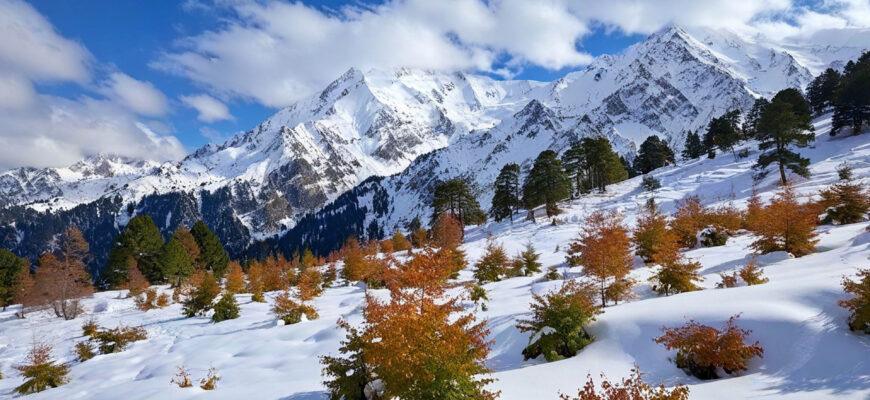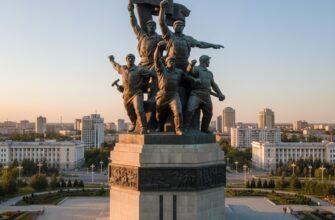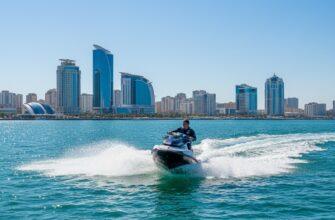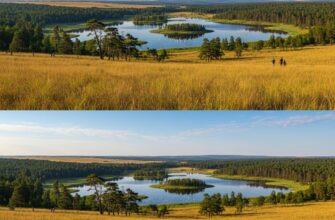Katon-Karagay National Park: Kazakhstan’s Ultimate Wilderness Experience
Nestled in the far eastern reaches of Kazakhstan, where the borders of Kazakhstan, Russia, China, and Mongolia converge, Katon-Karagay National Park stands as the country’s largest protected natural area and one of Central Asia’s most impressive yet undiscovered treasures. Spanning over 643,477 hectares of pristine wilderness, this remarkable park offers visitors an exceptional combination of majestic mountain landscapes, ancient historical sites, healing thermal springs, and rich biodiversity. Since its establishment in 2001 and subsequent recognition as a UNESCO Biosphere Reserve in 2014, the park has maintained a delicate balance between conservation and sustainable tourism, making it an ideal destination for nature enthusiasts, adventure seekers, and cultural explorers alike.
Overview of Katon-Karagay National Park
Katon-Karagay National Park is situated in the East Kazakhstan Region, approximately 1,000 kilometers southeast of the capital city of Astana. This magnificent protected area lies within the Southern Altai Mountains, creating a dramatic landscape of snow-capped peaks, glaciers, alpine meadows, and dense forests. The park encompasses a variety of ecosystems, from alpine tundra to steppe and semi-desert regions, with approximately 34% of its territory covered by forests.
The park’s mountainous terrain features numerous glaciers and steep slopes, with altitudes frequently exceeding 3,000 meters above sea level. The crown jewel of the region is Belukha Mountain, standing at 4,506 meters (14,783 ft), which marks the highest peak in Siberia and forms part of the border with Russia in the Katun Range. The landscape showcases classic glacial formations, including trough-shaped valleys, cirques, and moraines, while glacier-fed rivers create energetic waterways throughout the park.
Since becoming part of the transnational “Altai” park with Russia in 2011 and receiving UNESCO Biosphere Reserve status in 2014, Katon-Karagay has been recognized for both its exceptional natural values and sustainable management practices.
How to Reach Katon-Karagay
Getting to Oskemen (Ust-Kamenogorsk)
The journey to Katon-Karagay National Park begins with travel to Oskemen (also known as Ust-Kamenogorsk), the capital of East Kazakhstan Region. This city serves as the gateway to the park and is accessible via several transportation options:
- By Train: Regular train services connect Oskemen with major Kazakh cities including Astana, Semey (Cemey), and Almaty.
- By Air: Oskemen has an international airport with flights from Almaty and other major cities.
From Oskemen to Katon-Karagay
Once in Oskemen, transportation options to Katon-Karagay become more limited:
- Shared Taxi: The primary mode of transportation from Oskemen to Katon-Karagay is by shared taxi. Most locals use the taxi app called InDrive to arrange transportation.
- Cost: Expect to pay between 6,000-8,000 KZT (approximately 12-16€) for a one-way journey. Be cautious of drivers who may attempt to charge foreign tourists higher rates.
- Journey Duration: The trip takes approximately 6 hours, traversing through beautiful landscapes of the East Kazakhstan region.
Travel Tips
- It’s advisable to arrange your taxi with the help of a local or your accommodation in Oskemen to ensure fair pricing.
- The InDrive app is widely used and can help secure reliable transportation.
- Consider booking accommodation in advance, as options in Katon-Karagay are limited.
- Bring cash, as credit card facilities may be limited in rural areas.
Major Attractions in Katon-Karagay National Park
Belukha Mountain
Rising majestically at the border between Kazakhstan and Russia, Belukha Mountain (4,506 meters) is the highest peak in the Altai Mountains and all of Siberia. This imposing three-peaked massif, perpetually covered with snow and glaciers, offers breathtaking views and challenging climbs for experienced mountaineers. Even from a distance, the mountain creates an awe-inspiring backdrop to the park’s landscapes.
Rakhmanov Springs and Lake
The Rakhmanov Springs constitute several thermal springs located at an altitude of 1,760 meters above sea level. These springs have gained fame for their medicinal properties:
- Water temperatures range from +34°C to +42°C
- Rich mineral content with beneficial radon and nitrogen combinations
- Known for treating ailments related to movement, spine, and skin diseases
According to local legend, the springs were discovered by a hunter named Rakhmanov who witnessed a wounded deer regain strength after bathing in the waters. The hunter himself reportedly lived to the impressive age of 102 years, further enhancing the springs’ reputation for health benefits.
Adjacent to the springs lies Rakhmanov Lake, a stunning body of water stretching 2.6 kilometers in length. The lake features remarkably clear greenish-blue waters with a transparency of approximately 7.8 meters. Nestled between forested mountain slopes, the lake creates a picturesque setting for relaxation and photography.
Valley of Kings (Berel Burial Mounds)
Located near the village of Berel, approximately seven kilometers west at an altitude of 1,120 meters, the Valley of Kings contains ancient burial mounds (kurgans) dating to the 3rd-4th centuries BC. This archaeological site has yielded remarkable discoveries:
- Exceptionally preserved human and animal remains, including horses
- Wooden tables with intricate carvings
- Gold jewelry, felt and wool rugs, and household tools
The extraordinary preservation of these artifacts is attributed to the ingenious construction of the burial mounds, which allowed the contents to freeze rapidly and remain in a permanently frozen state. The kurgans were built in such a way that their chambers remain below the freeze line, even during summer months when the soil only defrosts to depths of 2-4 meters.
Locally known as the “Valley of Tsars,” this sacred place continued to hold significance for nomadic peoples long after its original construction, with grave mounds being built in the area throughout the first millennium AD.
Kokkol Waterfall
At 80 meters in height, Kokkol Waterfall stands as the largest waterfall in the Altai Mountains. This impressive cascade creates a dramatic spectacle as glacier-fed waters plunge down rocky cliffs, surrounded by pristine forest. The waterfall is accessible via hiking trails and offers excellent opportunities for nature photography.
Accommodation Options
Hotels and Guesthouses
Accommodation options in Katon-Karagay are limited but growing to meet increasing tourism demand. In the village of Katon-Karagay itself, visitors can find:
- 1-2 small hotels
- Several family-run guesthouses
One recommended option is the Altai-arai guest house (coordinates: 49.1752968, 85.6096761), which offers clean accommodations at prices ranging from 6,000-8,000 KZT per night (approximately 12-16€), with potential discounts for students.
Camping and Glamping
For those seeking a closer connection to nature, the park provides:
- Designated campgrounds throughout various zones
- Camping equipment rental services for visitors
The park is also developing innovative “glamping” (glamorous camping) facilities as part of its eco-tourism initiatives. These provide a more comfortable wilderness experience while maintaining environmental sustainability. The KazGlamping concept aims to offer high-quality tourist services while adhering to sustainable development principles.
Activities and Experiences
Hiking and Nature Exploration
The diverse terrain of Katon-Karagay National Park offers exceptional hiking opportunities for all skill levels:
- Alpine meadow trails with panoramic mountain views
- Forest paths showcasing the park’s rich biodiversity
- Riverside walks along glacier-fed streams
- High-altitude treks for experienced mountaineers
The park provides necessary hiking gear and guides for those unfamiliar with the terrain.
Health and Wellness at Rakhmanov Springs
The Rakhmanov Springs Sanatorium, situated near the northwest coast of Rakhmanov Lake, offers health-focused experiences:
- Therapeutic bathing in mineral-rich thermal waters
- Traditional treatments for various health conditions
- Relaxation in pristine mountain environments
The combination of thermal waters, mountain air, and peaceful surroundings creates an ideal environment for physical and mental rejuvenation.
Historical and Archaeological Exploration
Beyond the Valley of Kings, the park contains numerous sites of historical interest:
- Ancient rock carvings and petroglyphs
- Traditional Kazakh settlements
- Evidence of early human habitation in the Altai region
Educational programs and guided tours help visitors understand the rich cultural heritage of the area.
Wildlife Observation
The park’s diverse ecosystems support a rich variety of wildlife:
- At least 21 species of mammals documented in just one forestry area (Arshata)
- Several rare and endangered species
- Diverse bird populations
- Alpine and forest plant communities
Guided wildlife tours offer opportunities to observe these animals in their natural habitats while adhering to conservation principles.
Practical Information for Travelers
Transportation Within the Park
Once in Katon-Karagay, visitors have several options for exploring the park:
- Local Taxis: Available for trips to specific destinations like Berel or Rakhmanov Springs
- Park Vehicles: The park administration provides vehicles for organized tours
- Hitchhiking: While possible, this method is less reliable and not recommended for travelers with tight schedules
Border Zone Considerations
Parts of the park lie within Kazakhstan’s border zone with Russia and China, requiring special permits:
- The village of Uryl, 60km east of Katon-Karagay, marks the beginning of the border zone
- Entry permits can be arranged through travel agencies in Oskemen
- Allow sufficient time (several days) for permit processing before your trip
Recommended Gear and Preparation
Given the remote location and variable mountain weather, proper preparation is essential:
- Warm, layered clothing (even in summer)
- Sturdy hiking boots
- Rain gear
- Sun protection
- Basic first aid supplies
- Cash (ATMs are scarce)
- Russian or Kazakh phrasebook (English is not widely spoken)
Sustainable Tourism in Katon-Karagay
Conservation Efforts
The park administration is dedicated to preserving the region’s unique ecosystems while allowing for sustainable tourism development:
- Regular monitoring of environmental conditions
- Research on local flora and fauna
- Habitat protection for endangered species
Studies on the adaptive morphological responses of white willow (Salix alba L.) growing in the floodplain of the Bukhtarma River indicate the high bioecological condition of stands and soils in the region.
Tourism Carrying Capacity
Research has established specific carrying capacities for different zones within the park to prevent environmental degradation:
- Quiet recreation zones: up to 5 people per hectare
- Active recreation zones: between 20-100 people per hectare
These guidelines help maintain the balance between visitor enjoyment and ecological preservation.
Eco-friendly Practices for Visitors
Travelers are encouraged to follow responsible tourism practices:
- Stay on marked trails
- Pack out all waste
- Respect wildlife by maintaining distance
- Support local communities by purchasing local products and services
- Minimize water use, especially in areas with limited resources
Suggested Itineraries
3-Day Katon-Karagay & Rakhmanov Springs Tour
Day 1:
- Arrival in Katon-Karagay from Oskemen
- Accommodation setup and orientation
- Evening exploration of the village and local culture
Day 2:
- Morning journey to Rakhmanov Springs (by taxi or organized transport)
- Therapeutic bathing in the springs
- Hiking around Rakhmanov Lake
- Overnight stay near the springs
Day 3:
- Morning hike to nearby viewpoints
- Return to Katon-Karagay
- Departure or extension to other attractions
3-Day Katon-Karagay & Yazev Lake Tour
Day 1:
- Arrival in Katon-Karagay
- Exploration of the village and surroundings
Day 2:
- Full-day excursion to Yazev Lake
- Hiking in the alpine meadows
- Photography of mountain landscapes
- Return to accommodation
Day 3:
- Visit to local nature interpretation center
- Final activities and departure
Week-long Comprehensive Exploration
For those with more time, a week-long itinerary allows for a deeper exploration of the park’s diverse attractions:
- Days 1-2: Katon-Karagay village and immediate surroundings
- Days 3-4: Rakhmanov Springs and Lake
- Day 5: Valley of Kings (Berel Burial Mounds)
- Day 6: Kokkol Waterfall trek
- Day 7: Return to Oskemen
Things to Do in Katon-Karagay in 2025
As tourism infrastructure continues to develop in the region, visitors to Katon-Karagay in 2025 can look forward to enhanced experiences:
New Glamping Experiences
The KazGlamping initiative is expected to be fully operational by 2025, offering luxury camping experiences that combine comfort with environmental sustainability. These facilities aim to create employment opportunities for local communities while preserving the park’s natural features.
Enhanced Wellness Tourism
Building on the traditional appeal of Rakhmanov Springs, new wellness programs combining thermal therapy with modern health approaches are being developed. These will allow visitors to experience both traditional and contemporary healing practices.
Cultural Immersion Programs
Expanded opportunities to engage with local communities and learn about Kazakh traditions, including:
- Traditional craft workshops
- Culinary experiences featuring local specialties
- Folklore performances and storytelling sessions
Scientific Tourism
For those with specific interests in ecology, geology, or archaeology, specialized scientific tourism programs will provide in-depth exploration of the park’s natural and cultural resources under the guidance of researchers and experts.
Conclusion
Katon-Karagay National Park represents one of Kazakhstan’s most extraordinary natural treasures, combining spectacular mountain landscapes with rich biodiversity and fascinating cultural heritage. From the majestic Belukha Mountain to the healing waters of Rakhmanov Springs and the ancient mysteries of the Valley of Kings, the park offers experiences that appeal to adventurers, wellness seekers, history enthusiasts, and nature lovers alike.
Despite being somewhat challenging to reach, the effort required to visit Katon-Karagay is richly rewarded with authentic experiences far from the beaten tourist path. As sustainable tourism initiatives continue to develop, including innovative accommodations like glamping facilities, the park maintains its commitment to preserving its unique natural and cultural values for future generations.
For travelers seeking an alternative to more familiar destinations in Central Asia, Katon-Karagay provides an unparalleled opportunity to explore one of the region’s last true wilderness areas while contributing to its conservation and the wellbeing of local communities. Whether you’re drawn by the promise of alpine adventures, healing thermal waters, or ancient Scythian mysteries, Katon-Karagay National Park stands ready to offer experiences that will linger in your memory long after your journey has ended.









